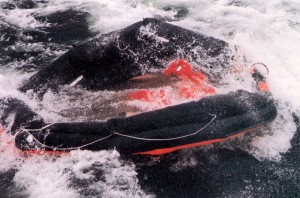
One of the life rafts survivors clung to while waiting to be rescued. Photo by Accident Investigation Board Finland.
TALLINN — Today relatives of those who perished marked the 15-year anniversary of one of the world’s worst peacetime maritime disasters — the sinking of the MS Estonia where 852 people drowned in stormy seas on their way to Stockholm from Tallinn.
The sinking, which happened about halfway between Tallinn and Stockholm, is the thirteenth deadliest peacetime maritime disaster in history. Exactly why it sank has never been definitively answered.
The cruiseferry sunk after the cargo hold door, or visor, broke open flooding the ship with water, but there is dispute about how the door was forced opened.
The official accident report produced in 1997 by a joint commission from Sweden, Estonia and Finland said weak, poorly built locks on the 50 ton visor were snapped by the storm waves. However, years after the sinking, it was revealed that military equipment had been aboard the ship earlier in the week, prompting people to suspect an explosion. The Swedish government denied however that there had been any equipment on board that day.
After the door broke water rushed through the visor, which is opened at port allowing people to drive their cars into the cargo hold, flooding the ship in just 50 minutes.
At 1:50 a.m the ship went under, settling 70 meters down on the seabed. Just 137 survivors — mostly men — survived, 94 of them passengers and 43 crew members.
A surviving crew member told his survival story on a blog about maritime disasters.
“We were lucky to get into a life raft; the ship had automated life rafts that inflate and surface when the ship sinks, but it was so cold, and there was lots of water in the raft as well. We knew from our training that hypothermia was our worst enemy so we tried to sit together with 11-12 other people in the raft,” Steinar Dørumsgaard Varsi wrote.
“We sat there for hours until rescue helicopters came and started to pick up the survivors, in our raft only eight people made it. We had to warm ourselves with the small amount of heat left in the bodies. That’s one thing that I’ll never forget.”
Conjecture
Despite talk of a cover up and the unresolved military equipment debate, an Estonian government commission established in 2005, concluded in February this year that a design and construction flaw in the bow door was the most likely cause of the disaster and found no link to the covert transportation of military equipment on board.
The commission did not entirely rule out the possibility that there may have been a hole in the hull, though an interim report published in 2007 discounted theories that one could have been caused by an explosion of undeclared military ordinance, as some relatives of victims have suggested.













